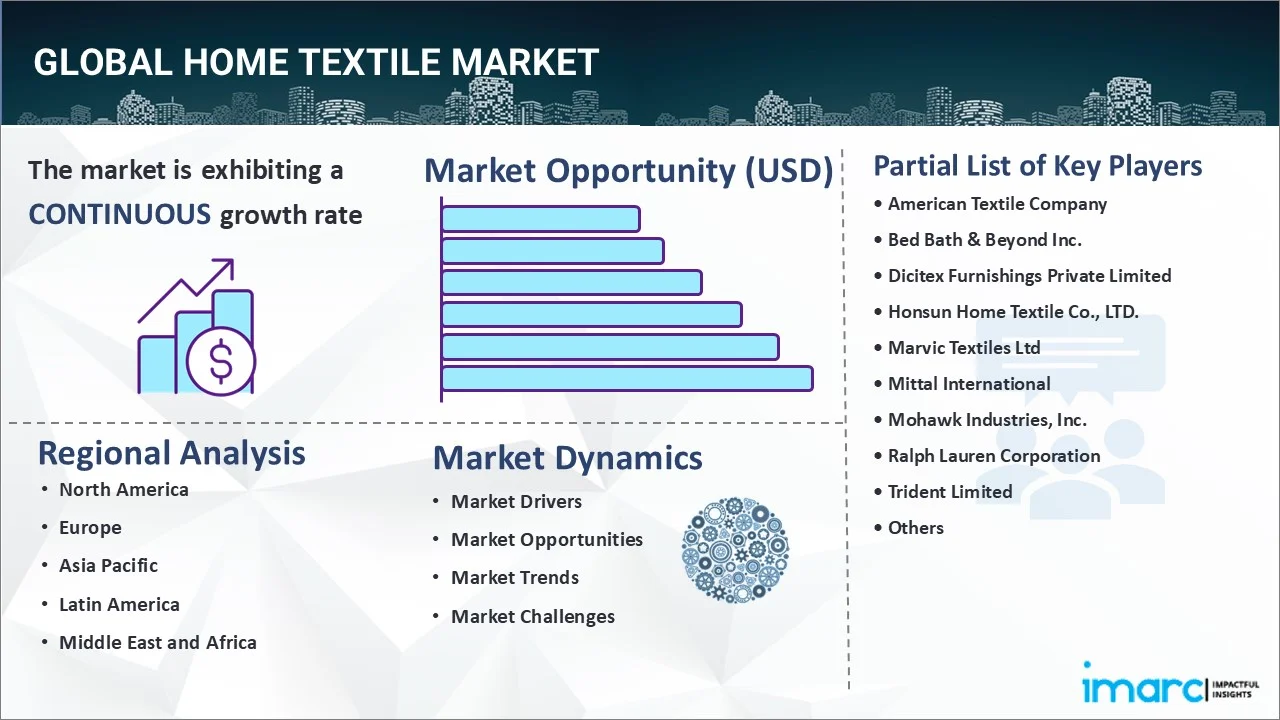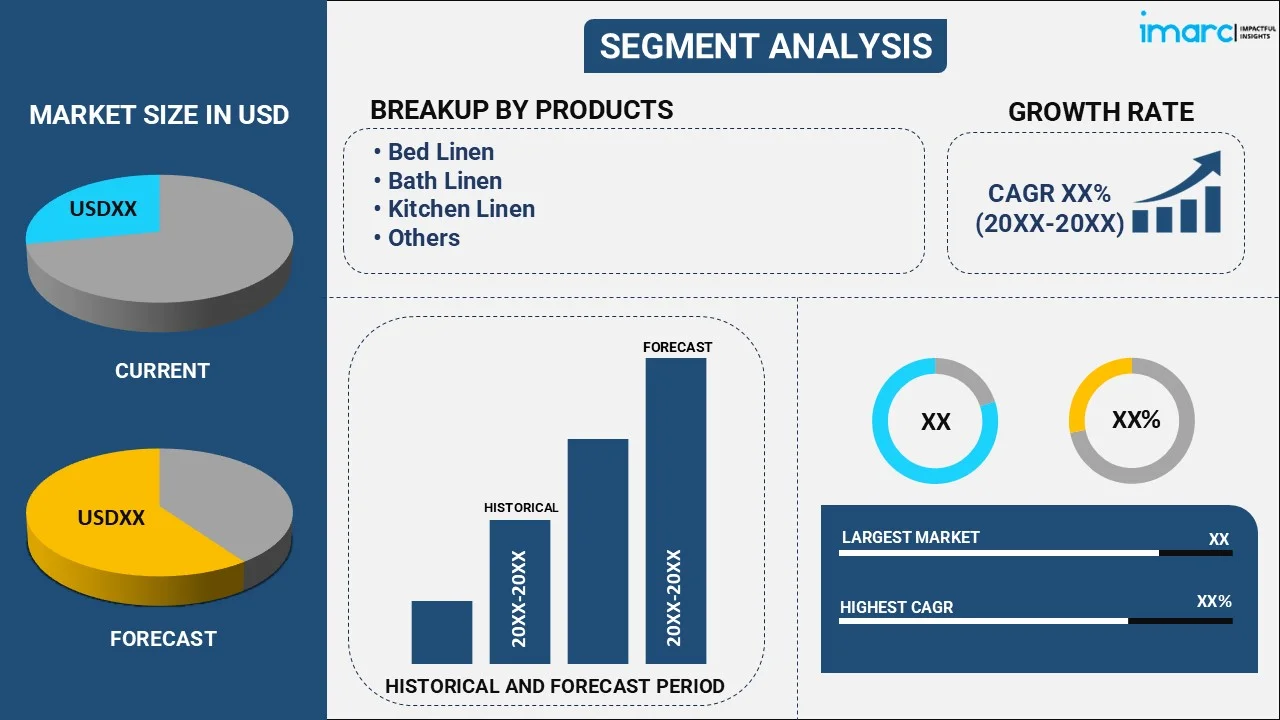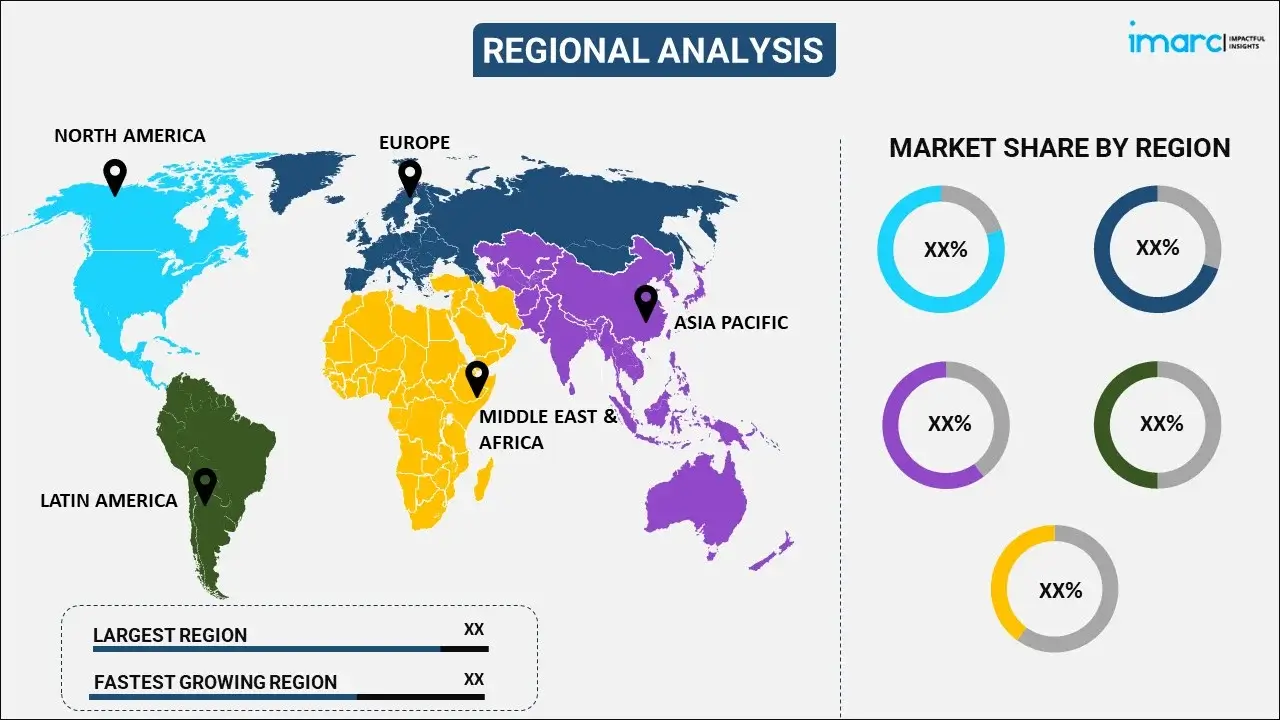
Home Textile Market Report by Product (Bed Linen, Bath Linen, Kitchen Linen, Upholstery, and Others), Fabric Type (Polyester, Cotton, Silk, Wool, and Others), Distribution Channel (Offline, Online), and Region 2025-2033
Market Overview:
The global home textile market size reached USD 132.0 Billion in 2024. Looking forward, IMARC Group expects the market to reach USD 201.5 Billion by 2033, exhibiting a growth rate (CAGR) of 4.82% during 2025-2033. The rising influence of emerging fashion and interior design trends, an enhanced focus on comfort and luxury, the inflating disposable income levels of the masses and continual product innovations are some of the major factors propelling the home textile market.
|
Report Attribute
|
Key Statistics
|
|---|---|
|
Base Year
|
2024 |
|
Forecast Years
|
2025-2033
|
|
Historical Years
|
2019-2024
|
| Market Size in 2024 | USD 132.0 Billion |
| Market Forecast in 2033 | USD 201.5 Billion |
| Market Growth Rate (2025-2033) | 4.82% |
Home textiles refer to a category of textile products used in residential settings, primarily for decorating and furnishing homes, serving both functional and aesthetic purposes to enhance the comfort, style, and overall ambience of a home. Fabrics used in home textiles are often soft, breathable, and pleasant to touch, and are designed to withstand regular use and laundering, ensuring longevity and maintaining their appearance over time. These products include items such as bedding, curtains, towels, rugs, tablecloths, upholstery fabrics, and other textile accessories used in interior decoration.

The global market is driven by the inflating disposable income levels, particularly in emerging economies, resulting in higher investment in home decor and furnishings. In line with this, rapid urbanization leading to a higher number of residential constructions and urban dwellings is creating lucrative opportunities in the market. Moreover, an enhanced focus on eco-friendly and ethically sourced products is leading to the demand for sustainable and organic home textiles. Furthermore, the emerging trend of home renovation and remodeling projects due to the rapidly changing lifestyles of the consumers are creating a positive outlook for the market. In addition to this, easy product availability across online and offline retail channels is providing an impetus to the market.
Home Textile Market Trends/Driver:
Growing awareness regarding home aesthetics among the masses
The increasing awareness among consumers regarding home aesthetics and transforming their living spaces into visually appealing and comfortable environments is fueling the market. Hence, there is an inclination toward home textiles such as curtains, beddings, rugs, and decorative fabrics to enhance the overall ambience and style of the home. As a result, individuals are increasingly purchasing textiles that reflect their personal tastes and create a cohesive and inviting atmosphere. Additionally, the advent of social media platforms and home decor websites has played a significant role in increasing the awareness of home aesthetics among the masses.
Considerable growth in the hospitality industry
The rapid utilization of luxurious and comfortable environments through the use of high-quality home textiles in the hospitality sector, such as hotels and homestays, are driving the market. This can be attributed to the expansion of the global tourism industry along with the rising number of travelers. The increasing investments in home textiles that can elevate the aesthetic appeal of their living spaces is acting as a significant growth-induing factor for the market. Also, an enhanced focus on premium fabrics that are soft, durable, and aesthetically pleasing in hotels to ensure guest satisfaction is creating lucrative opportunities in the market.
Increasing awareness of health and wellness
The rising consciousness regarding the potential health risks associated with certain materials and chemicals used in home textiles among consumers is an important factor driving the market. In line with this, the shifting preference for textiles that promote a healthier living environment is providing an impetus to the market. As a result, there is an augmented demand for home textiles made from natural and organic materials, such as organic cotton, bamboo, and linen. Additionally, the rising need for home textile products that are hypoallergenic, antimicrobial, and free from harmful chemicals is further creating a positive market outlook.
Home Textile Industry Segmentation
IMARC Group provides an analysis of the key trends in each segment of the global home textile market report, along with forecasts at the global, regional, and country levels for 2025-2033. Our report has categorized the market based on product, fabric type and distribution channel.
Breakup by Product:

- Bed Linen
- Bath Linen
- Kitchen Linen
- Upholstery
- Others
Bed linen hold the dominant share in the home textile market
The report has provided a detailed breakup and analysis of the home textile market based on the product. This includes bed linen, bath linen, kitchen linen, upholstery, and others. According to the report, bed linen represented the largest segment.
Bed linen products play a significant role in enhancing the visual appeal of bedrooms, thereby propelling the growth of the segment. Also, consumers are inclined toward attractive designs, patterns, colors, and textures that complement their personal style and home décor, which results in higher sales.
Bed linen products are expected to withstand regular use and frequent washing without significant wear or tear, therefore they are hugely preferred by consumers as a cost-effective home textile product.
Additionally, the usage of high-quality materials exudes a luxurious ambience. Furthermore, the rising popularity of other linen products with hypoallergenic properties and resistance to allergens, dust mites, or bacteria among health-conscious consumers are also propelling the growth of other segments.
Breakup by Fabric Type:
- Polyester
- Cotton
- Silk
- Wool
- Others
Polyester dominates the home textile market
The report has provided a detailed breakup and analysis of the home textile market based on the fabric type. This includes polyester, cotton, silk, wool, and others. According to the report, polyester represented the largest segment.
Polyester is typically more affordable compared to natural fibers like cotton or silk, and therefore cost-effectiveness is leading to a higher popularity among price-conscious consumers. Additionally, polyester fabric is known for its strength, durability and resistance to wrinkles, stretching, and shrinking, making it suitable for various applications.
The requirement for minimal ironing or special handling as well as additional properties such as water resistance, moisture-wicking, and flame retardancy provided by polyester is also resulting in a higher product uptake. Apart from this, the growing usage of engineered polyester fabric in mimicking the appearance and texture of natural fibers is also creating a positive segment outlook.
Furthermore, continual technological advancements in cotton, silk and wool manufacturing technologies leading to the development of fabrics with improved breathability, comfort, and eco-friendly features are further propelling the growth of other segments.
Breakup by Distribution Channel:
- Offline
- Supermarket/Hypermarket
- Specialty Stores
- Others
- Online
Offline distribution channel hold a larger share in home textile market
A detailed breakup and analysis of the home textile market based on the distribution channel has also been provided in the report. This includes offline (supermarket/hypermarket, specialty stores and others) and online. According to the report, offline accounted for the largest market share.
The main factor driving the growth of this segment is the opportunity of personalized shopping experience with consumers physically interacting with the products, feeling the textures, and evaluating the quality themselves. The additional assistance of knowledgeable sales staff who can provide product recommendations and address customer queries is also an important factor driving the segment’s growth. Moreover, immersive brand experiences through visual merchandising, product displays, and in-store promotions in physical showrooms is another significant factor that is creating lucrative growth opportunities for the segment.
On the other hand, the enhanced convenience and accessibility to a wide array of collection with flexible payment modes and convenient exchange/return policies is providing an impetus to the growth of the online segment.
Breakup by Region:

- North America
- United States
- Canada
- Europe
- Germany
- France
- United Kingdom
- Italy
- Spain
- Others
- Asia Pacific
- China
- Japan
- India
- South Korea
- Australia
- Indonesia
- Others
- Latin America
- Brazil
- Mexico
- Others
- Middle East and Africa
Asia Pacific exhibits a clear dominance, accounting for the largest home textile market share
The report has also provided a comprehensive analysis of all the major regional markets, which include North America (the United States and Canada); Europe (Germany, France, the United Kingdom, Italy, Spain, and others); Asia Pacific (China, Japan, India, South Korea, Australia, Indonesia, and others); Latin America (Brazil, Mexico, and others); and the Middle East and Africa.
The Asia Pacific region has a strong presence of numerous textile manufacturing facilities in key regions of numerous countries, such as China, India, Bangladesh, and Vietnam, which is an essential factor driving the market. In addition to this, the expanding population along with rapid urbanization rates in this region is resulting in an augmented demand for housing and residential spaces, which, in turn, is fueling the demand for home textiles.
In addition to this, considerable economic growth and improving living standards in countries across the Asia Pacific region is leading to increased investments on premium and high-quality aesthetically appealing home textile products. Furthermore, significant growth in the hospitality industry across the region is resulting in a higher product uptake across hotels, resorts, and other accommodation facilities present in the region.
Competitive Landscape:
The top players in the global home textile market are investing in research and development to introduce innovative and unique products to gain a competitive market edge. The major companies are also expanding their product portfolios to cater to a broader customer base, capture a larger market share and diversify their revenue streams. In addition to this, they are also entering into strategic partnerships and collaborations with other companies to develop joint product development, co-branded collections, and exclusive distribution agreements. Furthermore, an enhanced focus on brand-building activities, such as advertising campaigns, social media presence, and participation in trade shows and exhibitions is creating a positive market outlook.
The report has provided a comprehensive analysis of the competitive landscape in the global home textile market. Detailed profiles of all major companies have also been provided. Some of the key players in the global home textile market include:
- American Textile Company
- Bed Bath & Beyond Inc.
- Dicitex Furnishings Private Limited
- Honsun Home Textile Co., LTD.
- Marvic Textiles Ltd
- Mittal International
- Mohawk Industries, Inc.
- Ralph Lauren Corporation
- Trident Limited
- Vescom B.V. (Vescom Groep B.V.)
- Welspun One Logistics Parks Pvt. Ltd
Recent Developments:
- In March 2023, American Textile Company (ATC) announced a partnership with the Swiss materials innovation company, HeiQ, and launched their new range of allergy-proof bedding products, equipped with the flagship HeiQ Allergen Tech.
- In April 2023, Bed Bath & Beyond Inc. launched a vendor consignment program with ReStore Capital, where ReStore Capital will purchase up to $120 million of pre-arranged merchandise from the key suppliers to supplement inventory levels at Bed Bath & Beyond.
- In September 2021, Dicitex introduced an anti-bacterial, anti-viral and anti-fungal bedding range with an enhanced emphasis on the usage of performance fabrics, such as water-repellent finish and stain-resistant and fire-retardant fabrics.
Home Textile Market Report Scope:
| Report Features | Details |
|---|---|
| Base Year of the Analysis | 2024 |
| Historical Period | 2019-2024 |
| Forecast Period | 2025-2033 |
| Units | Billion USD |
| Scope of the Report | Exploration of Historical and Forecast Trends, Industry Catalysts and Challenges, Segment-Wise Historical and Predictive Market Assessment:
|
| Products Covered | Bed Linen, Bath Linen, Kitchen Linen, Upholstery, Others |
| Fabric Types Covered | Polyester, Cotton, Silk, Wool, Others |
| Distribution Channels Covered |
|
| Regions Covered | Asia Pacific, Europe, North America, Latin America, Middle East and Africa |
| Countries Covered | United States, Canada, Germany, France, United Kingdom, Italy, Spain, China, Japan, India, South Korea, Australia, Indonesia, Brazil, Mexico |
| Companies Covered | American Textile Company, Bed Bath & Beyond Inc., Dicitex Furnishings Private Limited, Honsun Home Textile Co., LTD., Marvic Textiles Ltd, Mittal International, Mohawk Industries, Inc., Ralph Lauren Corporation, Trident Limited, Vescom B.V. (Vescom Groep B.V.), Welspun One Logistics Parks Pvt. Ltd, etc. |
| Customization Scope | 10% Free Customization |
| Post-Sale Analyst Support | 10-12 Weeks |
| Delivery Format | PDF and Excel through Email (We can also provide the editable version of the report in PPT/Word format on special request) |
Key Questions Answered in This Report:
- How has the global home textile market performed so far, and how will it perform in the coming years?
- What are the drivers, restraints, and opportunities in the global home textile market?
- What is the impact of each driver, restraint, and opportunity on the global home textile market?
- What are the key regional markets?
- Which countries represent the most attractive home textile market?
- What is the breakup of the market based on the product?
- Which is the most attractive product in the home textile market?
- What is the breakup of the market based on the fabric type?
- Which is the most attractive fabric type in the home textile market?
- What is the breakup of the market based on the distribution channel?
- Which is the most attractive distribution channel in the home textile market?
- What is the competitive structure of the global home textile market?
- Who are the key players/companies in the global home textile market?
Key Benefits for Stakeholders:
- IMARC’s report offers a comprehensive quantitative analysis of various market segments, historical and current market trends, market forecasts, and dynamics of the home textile market from 2019-2033.
- The research study provides the latest information on the market drivers, challenges, and opportunities in the global home textile market.
- The study maps the leading, as well as the fastest-growing, regional markets. It further enables stakeholders to identify the key country-level markets within each region.
- Porter's five forces analysis assist stakeholders in assessing the impact of new entrants, competitive rivalry, supplier power, buyer power, and the threat of substitution. It helps stakeholders to analyze the level of competition within the home textile industry and its attractiveness.
- Competitive landscape allows stakeholders to understand their competitive environment and provides an insight into the current positions of key players in the market.
Need more help?
- Speak to our experienced analysts for insights on the current market scenarios.
- Include additional segments and countries to customize the report as per your requirement.
- Gain an unparalleled competitive advantage in your domain by understanding how to utilize the report and positively impacting your operations and revenue.
- For further assistance, please connect with our analysts.
 Inquire Before Buying
Inquire Before Buying
 Speak to an Analyst
Speak to an Analyst
 Request Brochure
Request Brochure
 Request Customization
Request Customization




.webp)




.webp)












